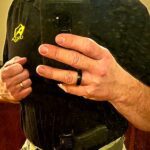Adopting AIWB
I recently made the switch from a strongside Inside the Waistband (IWB) hip holster to Appendix Inside the Waistband (AIWB) carry. I had been contemplating switching for more than a year, but as a firearms instructor I take the 4 Rules of Gun Safety very seriously. The decision to make the change did not come quickly, or easily as I was concerned about muzzling myself which violates one of the four rules. The four rules according to Col. Jeff Cooper and Gunsite are:
- All guns are always loaded
- Never let the muzzle cover anything you are not willing to destroy
- Keep your finger off the trigger until your sights are on the target
- Always be sure of your target
When you are sitting or bending over, carrying AIWB violates rule number 2, and this is what made me hesitant to switch. However, many of the instructors that I highly respect have already made the switch, and more and more students are showing up to classes with appendix carry rigs. As a firearms instructor, I also firmly believe that you need to be able to teach to the needs of the student, and since I personally didn’t have any experience with AIWB, I decided it was time to at least give it a try. The first objective was to find a “Safe, Comfortable and Quality Holster” so I went with a Keepers Concealment Cornerstone holster. Spencer Keepers is not only a friend, but an excellent instructor and his holsters are specifically designed for appendix carry. I will be honest, from a comfort standpoint the first two weeks were both physically and mentally uncomfortable. I struggled trying to find a holster that didn’t physically hurt, and every time I sat down or bent over to pick something up, the physical discomfort was a mental reminder that I was breaking a gun safety rule.
After about 2 weeks of trying to claw and wedge my way through the right combination of holster and concealment options, I found that I really began to like AIWB, especially while on the range. Not only was the draw from concealment faster (about a quarter second), but there was a lot less movement. Why is less movement important? Well, if you have ever done any force-on-force training, you will know that movement draws your eye and attention. So, if I am faced with an armed criminal and he/she turns their attention off of me, appendix carry allows me draw my firearm quicker, and have a more “surreptitious draw“. As you can see from the below videos and photos, my first shots from AWIB were about 2 – 3 tenths of a second faster, and my draw to first shot times were consistently around the 1 second mark.
Adopting AIWB – The First Shots in Slow Motion
Strong Side Carry
While I have managed a couple of sub-second draws from strong side, my average is usually around the 1.3 second mark and it requires much more concentration and a lot more movement. There are both Pros and Cons to Appendix carry, and one of the most detailed articles appropriately called “Concealed Carry: AIWB Carry Pros And Cons” written by our friend Massad Ayoob, covers the topic well. While some may still be concerned with the direction of the muzzle I am comfortable with AWIB for everyday carry. With a quality holster that completely covers the trigger guard, modern firearms, and proper techniques for drawing and re-holstering, AIWB is not only safe, but also more efficient. Ultimately, you will need to decide if AWIB is right for you. If you are considering it, I encourage you to do your own research, and A LOT of dry fire practice.




